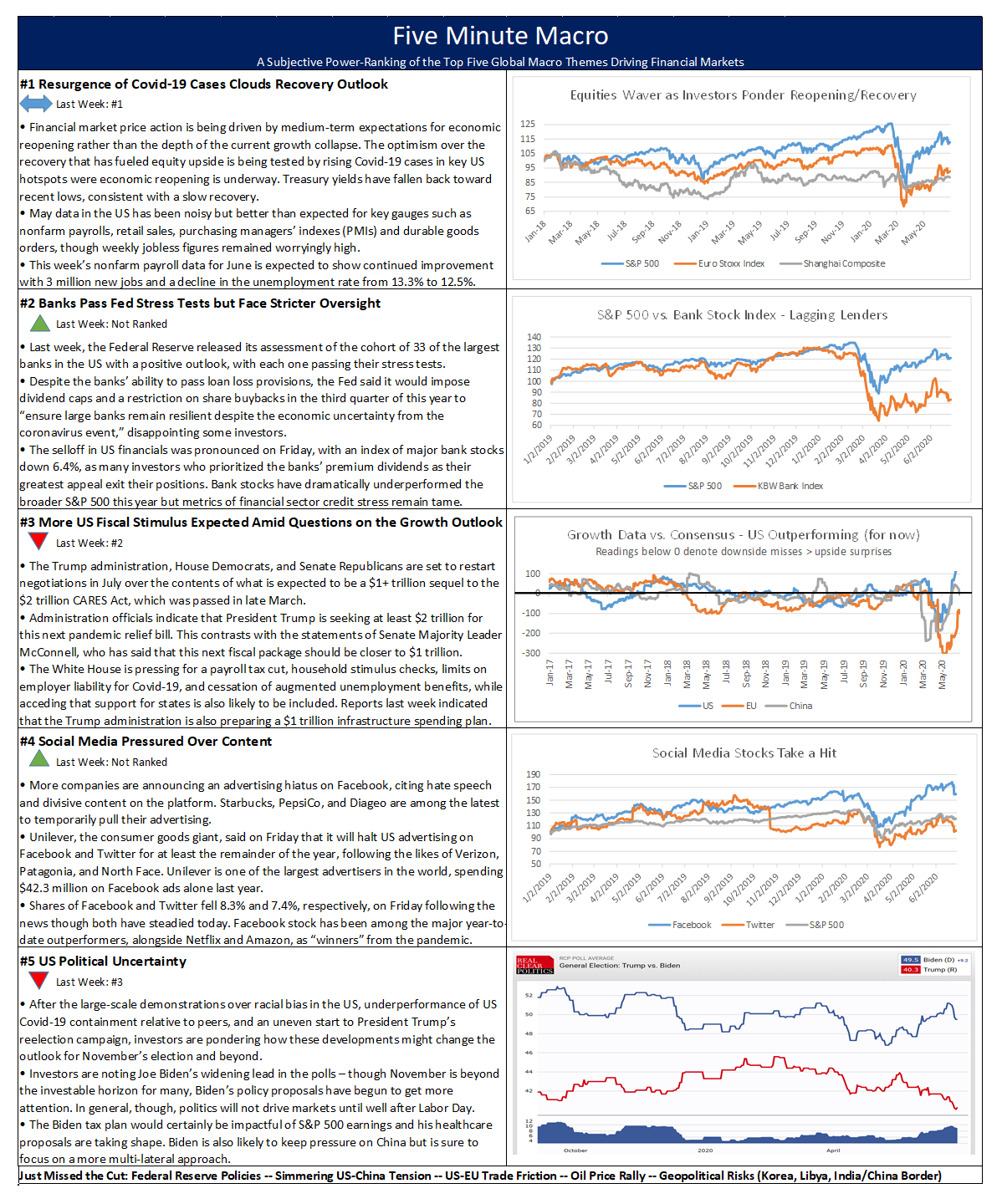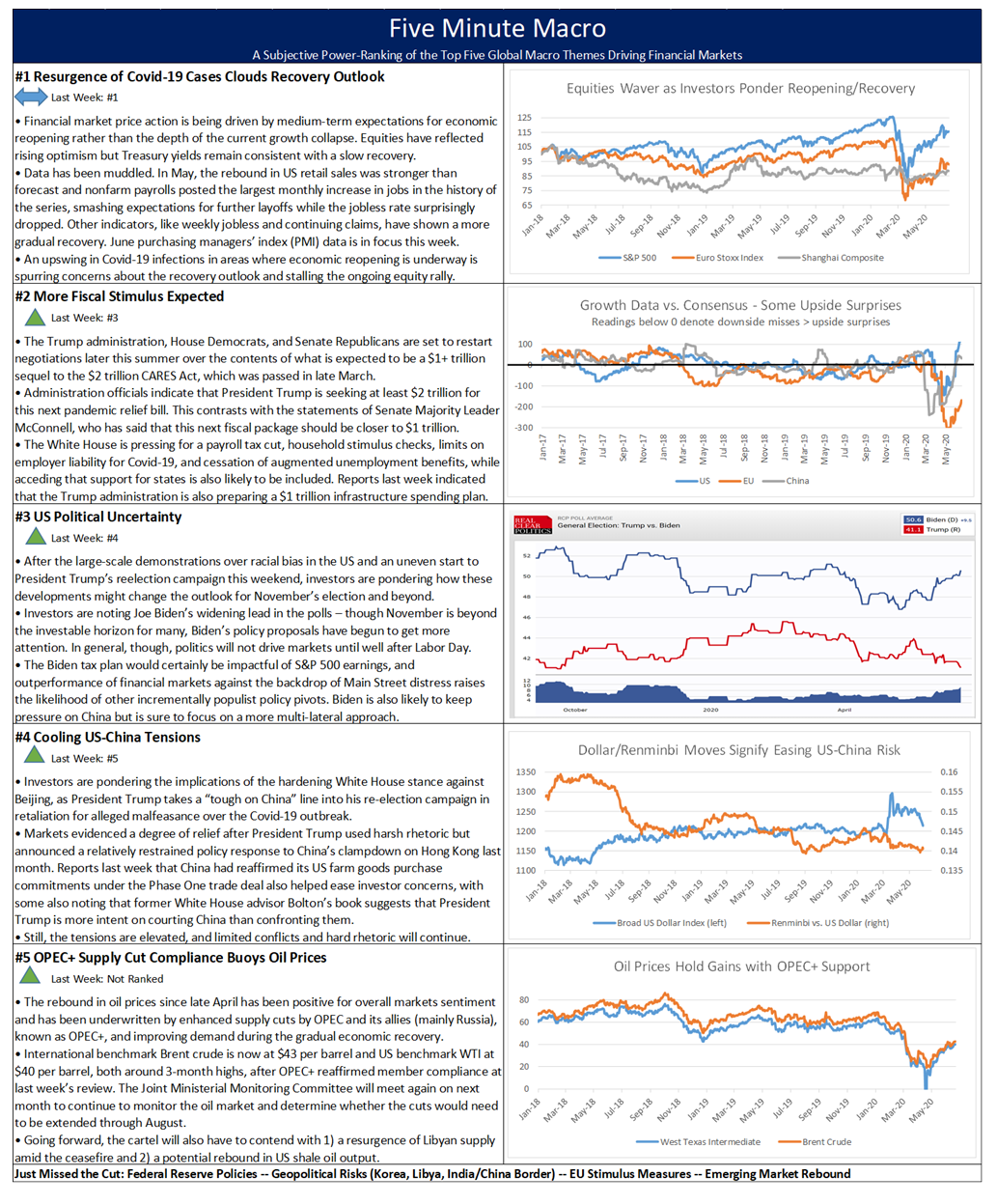Summary and Price Action Rundown
Global risk assets are settling lower this morning to begin third quarter trading on a cautious note as investors ponder the recovery outlook while awaiting key US data and more communications from the Federal Reserve. S&P 500 futures point to a 0.6% lower open after the index rallied another 1.5% yesterday, closing a positive second quarter of trading on an upbeat note and taking year-to-date downside to 4.0%. After the sharp rally from March lows topped in early June, volatility has remained elevated and US stocks have struggled for direction amid pronounced uncertainty over the interrelated economic and public health outlooks. Equities in the EU are down this morning while Asian stocks were mixed overnight. The dollar is moving higher while longer-dated Treasury yields are up from recent lows, with the 10-year yield at 0.68%. Brent crude prices are rising above $42 ahead of US inventory data.
Fed Accommodation in Focus Ahead of Meeting Minutes
Investors will parse the minutes of the June FOMC meeting for any additional insights on the policy outlook, particularly the Fed’s posture toward enhanced rate guidance or yield curve control. The Fed left its policy rate unchanged at 0-0.25% in the June 10th decision and no new policies were enacted, while the tone of the accompanying statement and Chair Powell’s press conference was decidedly dovish. According to the updated interest rate projections (the “dot plot”), all but two FOMC members expect that it will be appropriate to keep rates at zero through 2022. However, market participants were left uncertain regarding future policy maneuvers, with Chair Powell again only noting that forward guidance and yield curve control (YCC) are being considered, so the minutes will be scrutinized for signals on these points. Alongside the rate outlook, the Fed projected that the US economy will shrink 6.5% in 2020 but show a 5.0% gain in 2021 followed by 3.5% in 2022, with unemployment estimated to be 5.5% by the end of 2022. However, the range of forecasts is wide, with GDP for next year seen falling between -1% to 7% and unemployment from 4.5% to 12%, reflecting great uncertainty over the possible lingering impact of the virus. Yesterday, however, the tone of Chair Powell’s testimony before the House Financial Services Committee was more upbeat than his most recent communications during his Humphrey-Hawkins testimony before Congress last month and at his press conference following the June FOMC meeting, but re-emphasize the Fed’s commitment to use its “full range of tools” to support the recovery.
Uneven Global Economic Data Paints Mixed Picture of Recovery
China’s Caixin Manufacturing PMI for June unexpectedly rose to 51.2 in June from 50.7 the previous month, beating market consensus of 50.5 and tagging a six-month high. For context, PMI readings above 50 denote expansion in the sector. Output grew on the back of a renewed increases in new orders and buying levels rose the most since January 2018. On the other hand, export work continued to fall due to weak global demand. The Shanghai Composite posted a solid rally after these upbeat figures, though the renminbi remained stable versus the dollar. Contrastingly, the Bank of Japan’s Tankan index for large manufacturers’ sentiment plunged to an eleven-year low of -34 in the second quarter (Q2) from -8 in Q1, undershooting estimates of -31. For context, Tankan readings below zero indicate worsening conditions. Sentiment deteriorated the most among firms producing motor vehicles (-72 vs -17 in Q1). Still, large firms in Japan plan to raise their capital spending by 3.2%, up from 1.8% in the previous quarter and above a 2.1% expected decline. Among non-manufacturing large firms, sentiment tumbled to a 10-year low of -17 from 8 in Q1 and compared with expectations of -18. Meanwhile, German unemployment in June hit a five-year high of 6.4% and UK nationwide home prices fell 1.4% month-on-month in June after a 1.7% decline the prior month.
Additional Themes
FedEx Joins Pandemic “Winners” – Shares of the shipping bellwether are up 9.9% in pre-market trading after management issued better-than-anticipated earnings figures for their fiscal Q4 following yesterday’s closing bell. Cost savings in other areas offset increased spending on enhanced employee protection measures amid the pandemic while air cargo volume rose.
More Disheartening Covid-19 News – Economists from Goldman Sachs are estimating that 40% of the US has now halted or partly reversed reopening measures amid the resurgence of coronavirus cases in key hotspots. Yesterday, Texas recorded a new single-day high in cases while California registered its second highest daily tally. The EU will ban travelers from the US, while New York, New Jersey, and Connecticut have widened the number of states from which travelers will be required to quarantine for two weeks.


